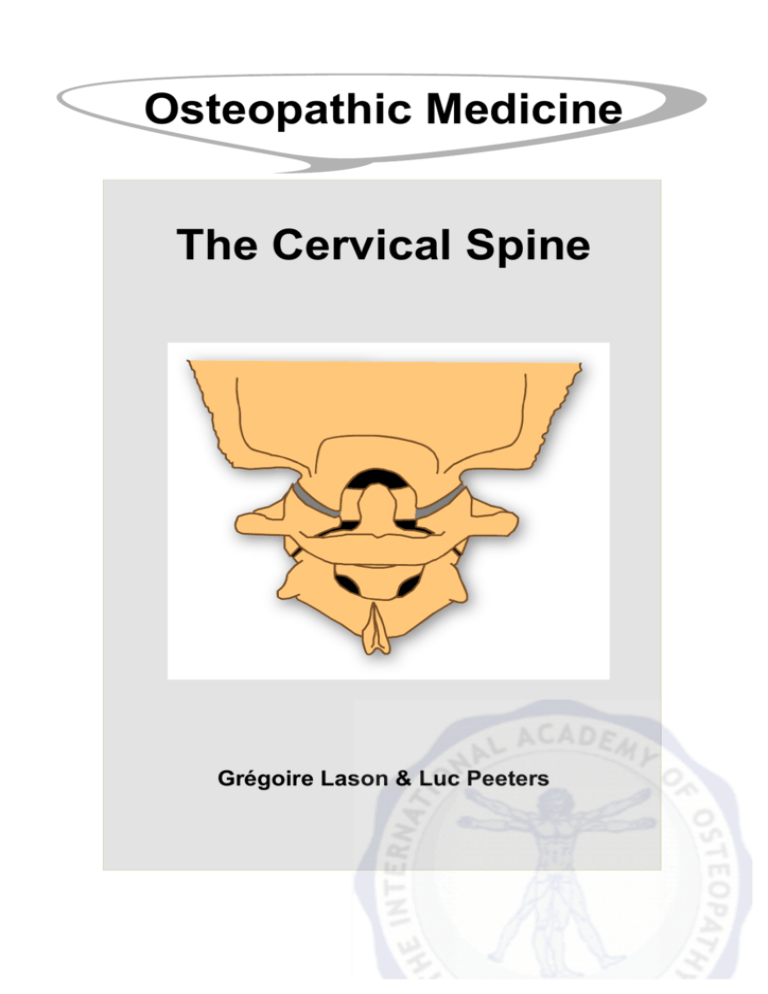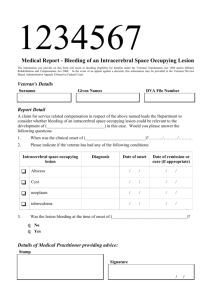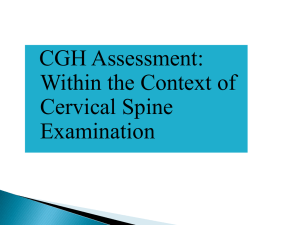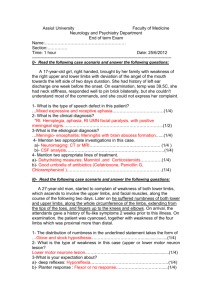
Osteopathic Medicine
The Cervical Spine
Grégoire Lason & Luc Peeters
The Cervical Spine
Grégoire Lason & Luc Peeters
All rights reserved. Osteo 2000 bvba © 2013. No part of this e-book may be reproduced or made
public by printing, photocopying, microfilming, or by any means without the prior written permission of
the publisher.
Contact: Osteo 2000, Kleindokkaai 3-5, B – 9000 Ghent, Belgium
Mail: info@osteopathie.eu
Web: http://osteopedia.iao.be and www.osteopathie.eu
Tel: +32 9 233 04 03 - Fax: +32 55 70 00 74
ISBN: 9789074400374
The International Academy of Osteopathy – I.A.O.
2
Content
Content ....................................................................................................................... 3
1. Introduction ............................................................................................................ 7
2. Biomechanics ........................................................................................................ 8
2.1. Normal Posture ............................................................................................... 8
2.2. Normal Motion ................................................................................................. 8
2.3. Joints ................................................................................................................ 9
2.3.1. Occiput – Atlas ........................................................................................... 9
2.3.2. Atlas – Axis ............................................................................................... 10
2.3.3. C2-7............................................................................................................ 13
2.4. Normal Biomechanics .................................................................................. 15
2.4.1. The Occiput-Atlas-Axis (OAA) Complex ................................................... 15
2.4.1.1. Flexion and Extension ........................................................................ 15
2.4.1.2. Sidebending ....................................................................................... 18
2.4.1.3. Rotation .............................................................................................. 19
2.4.2. C2-7............................................................................................................ 20
2.4.2.1. Flexion ............................................................................................... 20
2.4.2.2. Extension ........................................................................................... 21
2.4.2.3. Sidebending ....................................................................................... 22
2.4.2.4. C2-3 ..................................................................................................... 23
3. Lesional Mechanics ............................................................................................. 24
3.1. Occiput-Atlas-Axis (OAA) Compression Lesion ........................................ 27
3.2. Occiput Lesion in Flexion ............................................................................ 28
3.3. Occiput Lesion in Extension ........................................................................ 29
3.4. Occiput Lesion in ESLRR .............................................................................. 30
3.5. Occiput Lesion in FSLRR ............................................................................... 31
3.6. Occiput Lesion in right Shift (or atlas in left shift versus the occiput) .... 32
3.7. Atlas Lesion in RR ......................................................................................... 33
3.8. C3-7 Lesion in ERSR ........................................................................................ 34
3.9. C3-7 Lesion in FRSR ........................................................................................ 35
3.10. Lesion C2 in SLRR ........................................................................................ 36
4. Cervical Pain ........................................................................................................ 37
4.1. General ........................................................................................................... 37
4.2. Possible Causes of cervical Pain (Related to the cervical Spine) ............ 44
4.2.1. Degenerative Diseases ............................................................................ 44
4.2.1.1. Cervical Stenosis ............................................................................... 44
4.2.1.2. Cervical Stenosis through calcified longitudinal Ligament ................. 47
4.2.1.3. Rheumatoid Arthritis (RA) .................................................................. 47
4.2.1.4. Atlantoaxial instability ......................................................................... 50
4.2.1.5. Cervical Arthritis ................................................................................. 52
4.2.1.6. Oesophageal Compression in Osteoarthritis ..................................... 54
3
4.2.1.7. Upward Odontoid Migration ............................................................... 55
4.2.2. Vertebral Artery Pathology ....................................................................... 56
4.2.3. Lymph Nodes ........................................................................................... 60
4.2.4. Plexus brachialis Overstretch or Compression ......................................... 61
4.2.5. Herpes Zoster ........................................................................................... 61
4.2.6. Occipital Neuralgia ................................................................................... 62
4.2.7. Glossopharyngeal Neuralgia .................................................................... 63
4.2.8. Cervical Radiculopathy ............................................................................. 63
4.2.9. Cervicobrachial Neuralgia ........................................................................ 65
4.2.10. Cervical Rib Syndrome ........................................................................... 67
4.2.11. Whiplash ................................................................................................. 69
4.2.12. Cervical Posture ..................................................................................... 72
4.2.13. Upper Cross Syndrome .......................................................................... 74
4.2.14. Cervical Extension Syndrome ................................................................ 76
4.2.15. Cervical Spine in Children ...................................................................... 76
4.2.16. Atlantoaxial Rotatory Subluxation ........................................................... 77
4.2.17. Torticollis ................................................................................................ 77
4.2.18. KISS Syndrome ...................................................................................... 78
5. Examination ......................................................................................................... 81
5.1. Safety Tests ................................................................................................... 81
5.1.1. Neurological .............................................................................................. 81
5.1.1.1. Babinski Reflex .................................................................................. 81
5.1.1.2. Hautant Test ...................................................................................... 82
5.1.1.3. Nystagmus Test ................................................................................. 83
5.1.1.4. Provocation of the superior cervical Ganglion ................................... 85
5.1.1.5. Provocation of the stellate Ganglion .................................................. 85
5.1.1.6. Provocation of the stellate Ganglion .................................................. 86
5.1.1.7. Nerve Root Syndromes ...................................................................... 87
5.1.1.8. Sensibility Testing upper Extremity .................................................... 88
5.1.1.9. Muscle Force Testing upper Extremity .............................................. 88
5.1.1.10. Reflexes ........................................................................................... 89
5.1.1.10.1. Scapulohumeral Reflex Test ..................................................... 89
5.1.1.10.2. Biceps Reflex Test .................................................................... 89
5.1.1.10.3. Triceps Reflex Test ................................................................... 90
5.1.1.10.4. Radius Reflex Test .................................................................... 90
5.1.1.10.5. Finger Reflex Test ..................................................................... 91
5.1.1.10.6. Thumb Reflex Test .................................................................... 91
5.1.1.10.7. Pronation Reflex Test ................................................................ 92
5.1.1.10.8. Hoffmann-Trömmerreflex Test .................................................. 92
5.1.1.11. Neurological Provocation Tests ....................................................... 93
5.1.1.11.1. Test of Kemp ............................................................................. 93
5.1.1.11.2. Provocation Median Nerve ........................................................ 93
5.1.1.11.3. Provocation Median Nerve – alternative ................................... 94
4
5.1.1.11.4. Provocation Radial Nerve .......................................................... 94
5.1.1.11.5. Provocation Ulnar Nerve ........................................................... 95
5.1.2. Vascular .................................................................................................... 95
5.1.2.1. De Kleyn-Nieuwenhuyse Test ............................................................ 95
5.1.2.2. Traction Test of Occiput ..................................................................... 96
5.1.2.3. Palpation of the Carotid Artery Pulse ................................................. 97
5.1.2.4. Observation of the external and internal jugular Vein ........................ 97
5.1.2.5. Valsalva Manoeuvre .......................................................................... 98
5.1.2.6. Swallowing Test ................................................................................. 99
5.1.3. Mechanical ............................................................................................. 100
5.1.3.1. Test of the transverse Ligament ...................................................... 100
5.1.3.2. Hypermobility Test ........................................................................... 101
5.1.3.3. Cervical Compression Test (Spurling test) ...................................... 102
5.1.3.4. Stair Step Test ................................................................................. 103
5.2. Differential Test Musculoskeletal – Craniosacral .................................... 104
5.3. Mobility Tests .............................................................................................. 105
5.3.1. Active Test: Flexion and Extension (all levels) ....................................... 105
5.3.2. Passive Test in Flexion and Extension (sitting) (all levels) ..................... 105
5.3.3. Passive Test in Flexion and Extension (supine) (all levels) .................... 106
5.3.4. Passive Rotation Test (all levels) ........................................................... 106
5.3.5. Passive Sidebending Test (all levels) ..................................................... 107
5.3.6. Passive Flexion/Extension Test of the Occiput ...................................... 107
5.3.7. Passive Sidebending Test of the Occiput ............................................... 108
5.3.8. Passive Translation Test of the Occiput via the Atlas ............................ 109
5.3.9. Passive Rotation Test of the Atlas (supine) ............................................ 110
5.3.10. Passive Rotation Test of the Atlas (sitting) ........................................... 110
5.3.11. Passive Translation Test of the Atlas ................................................... 111
6. Techniques ......................................................................................................... 112
6.1. Mobilisations ............................................................................................... 112
6.1.1. General ................................................................................................... 112
6.1.2. Lesion in Extension (All levels) ............................................................... 113
6.1.3. Lesion in Flexion (all levels) ................................................................... 113
6.1.4. Lesion in Rotation (all levels) .................................................................. 114
6.1.5. Lesion in Sidebending (all levels) ........................................................... 114
6.1.6. Mobilisation of the ventral soft Tissues ................................................... 115
6.1.7. Mobilisation of the cervicothoracic Junction ........................................... 115
6.1.8. Passive Stretch of the posterior Muscles ............................................... 116
6.1.9. Massage of the suboccipital Muscles ..................................................... 116
6.2. ‘Osteopathic Manipulative Techniques’ .................................................... 117
6.2.1. General ................................................................................................... 117
6.2.2. Occiput Lesion in FSLRR ......................................................................... 120
6.2.3. Occiput Lesion in FSLRR – Manipulation via the Atlas ............................ 121
6.2.4. Occiput Lesion in ESLRR......................................................................... 122
5
6.2.5. Occiput Lesion in left Shift ...................................................................... 123
6.2.6. Atlas Lesion in rotation Right .................................................................. 124
6.2.7. Atlas Lesion in left Shift .......................................................................... 124
6.2.8. C2-C7 Lesion in FRSR (supine) ............................................................... 125
6.2.9. C2-C7 Lesion in ERSR ............................................................................. 125
6.2.10. C2-C7 Lesion in FRSR (sitting) ............................................................... 126
6.2.11. Atlas Lesion in right Rotation (sitting) ................................................... 126
6.2.12. C2-C7 Lesion in ERSR (sitting) .............................................................. 127
6.3. ‘Muscle Energy Techniques’ (M.E.T.) ........................................................ 128
6.3.1. General ................................................................................................... 128
6.3.2. Occiput Lesion in ESLRR......................................................................... 129
6.3.3. Occiput Lesion bilateral in Flexion .......................................................... 130
6.3.4. Occiput Lesion bilateral in Extension ...................................................... 130
6.3.5. Atlas Lesion in left Rotation .................................................................... 131
6.3.6. Lesions in the Region C2-C7 in FRSR ..................................................... 132
6.3.7. Lesions in the Region C2-C7 in ERSR ..................................................... 133
6.4. ‘Strain and Counterstrain Techniques’ ..................................................... 134
6.4.1. General ................................................................................................... 134
6.4.2. C1 and C2 Lesion in ERSL ....................................................................... 134
6.4.3. C3 and C4 Lesion in ERSL ....................................................................... 135
6.4.4. C5-T2 Lesion in ERSL .............................................................................. 135
6.4.5. C1 Lesion in FRSL ................................................................................... 136
6.4.6. C2 Lesion in FRSL ................................................................................... 136
6.4.7. C3 and C4 Lesion in FRSL ....................................................................... 137
6.4.8. C5 and C6 Lesion in FRSL ....................................................................... 137
6.4.9. C7 Lesion in FRSL ................................................................................... 138
6.4.10. C8 Lesion in FRSL ................................................................................. 138
7. Bibliography ....................................................................................................... 139
8. About the Authors ............................................................................................. 144
9. Acknowledgment ............................................................................................... 145
10. Osteopathic Terminology ............................................................................... 146
10.1. The three anatomical Axes ....................................................................... 146
10.2. The three anatomical Planes .................................................................... 147
10.3. Spinal Biomechanics ................................................................................ 148
10.4. General Abbreviations .............................................................................. 150
10.5. Specific Terms ........................................................................................... 151
11. All Video’s ........................................................................................................ 152
6
1. Introduction
The cervical spine is the region of the body that is best used to illustrate the concept
of osteopathic integration. Not only do dysfunctions in this region influence other
body regions via mechanical, neurological and vascular pathways but the opposite
also occurs – the cervical spine is often influenced by other regions via mechanical,
neurological and vascular pathways.
The cervical spine has both a static, supportive function for the head and associated
organs and a dynamic function for the head and associated special senses. The
combination of these two functions leads to a biomechanically complex region and as
a result the upper cervical spine has a different biomechanical function than the
middle and lower cervical spine.
This e-book explains the different biomechanics of these zones within the cervical
spine as well as providing written and visual description of relevant functional tests
and techniques.
The anatomy of the cervical spine can be found in standard anatomy books and is
only repeated here when there is specific relevance.
For those readers not familiar with the typical osteopathic terminology, read chapter
10.
For didactic reasons, the Fryette model is used. The relativity and utility of this model
is explained in the e-book ‘Integration and applied Principles in Osteopathy’ of the
same authors (http://osteopedia.iao.be).
The cervical spine is divided into two separate zones for biomechanical
description:
• The occiput-atlas-axis (OAA) complex.
• The C2-C7 region.
7
2. Biomechanics
(Benzel 2001, Bogduk & Merver 2000, Bogduk & Yoganandan 2001, Cusick &
Yoganandan 2002, Dvorak et al 1987, Dvorak et al 1993, Moore & Dalley 1999,
Fryette 1942, 1988, Grant 2004, Gray 1995, 2000, Herkowitz 2003, Huelke &
Nusholtz 1986, Kapandji 2001, Lovett 1900, 1905, Netter 2003, Pal et al 2001,
Panjabi & White 1990, 2001, Penning & Wilmink 1987, Schneck 2002, Sobotta 2001,
van Mameren 1992, White & Panjabi 1990)
2.1. Normal Posture
The cervical lordosis Occ-C7 averages 40°.
This normal lordotic curvature is necessary to transfer the weight of the head in an
economic way. Too little lordosis will lead to disc compression and too much lordosis
to facet compression, and therefore to dysfunction.
40°
Figure 1 - Normal cervical lordosis
Most of the lordosis occurs at the C1-2 segment.
2.2. Normal Motion
Normal range of motion:
Flexion
Extension
Sidebending
Rotation
50°
60°
45°
80°
Approximately 50% of the flexion-extension motion occurs at occiput-C1 (atlas) level.
Approximately 50% of the rotation occurs at C1-2 (atlas-axis) level.
Motion at the occiput-C1 segment is restricted primarily to flexion-extension due to
bony structures, ligamentous constraints, and the absence of an intervertebral disc.
Sidebending is also possible with some rotation added.
8
4. Cervical Pain
4.1. General
Cervical pain is a common cause for office visit. 34% of the people suffer from
cervical pain sometimes during their life, most of them are females.
The cause of cervical pain can be very different. Therefore it is important to find the
structure that causes the pain.
Is the pain caused by a muscle and if so which muscle(s)?
Is the pain caused by a ligament strain, and if so which ligament(s)? Are the
ligaments that cause the pain overstretched or are they retracted?
Is the pain caused by an inflamed joint and if so which joint?
Is the pain caused by an inflamed disc and if so at which level?
Is the pain caused by an inflamed nerve and if so which nerve and at what level is
the inflammation?
Is there spinal stenosis, fracture or tumour in the vertebral canal?
Are there specific bone diseases or rheumatic factors?
Are there local infections present?
Is there a visceral afference towards the segment occiput – atlas – axis (OAA)?
Is there a postural overload caused by lesions in other spinal areas?
Local cervical pain can originate from:
• The anterior longitudinal ligament.
• The posterior longitudinal ligament.
• The outer annulus.
• The dura mater.
• The facet joint capsule.
• The muscles.
• The ligaments.
The osteopath starts his/her investigation with a case history.
In the case history, the osteopath tries to identify the nature of the pain:
• Aching pain can be from a ligament, especially when occurring in the morning
with morning stiffness. Also when it occurs after a longer period of
immobilisation (sitting or standing).
• Sharp pain on specific movements can be caused by muscle strain or
inflammation.
37
•
•
Decompress the cervical canal by mobilising gently towards flexion without
irritating eventual fused segments.
Decompression can also be achieved by manual axial traction of the cervical
spine.
Let’s not forget that the structural damage that has been made by the canal stenosis
can’t be cured. This doesn’t mean that the suggested treatment is worthless, it will
often improve the symptoms and prevent the problem progressing.
Figure 48 - Cervical stenosis
Figure 49 - Wasting of small muscles in hands
46
5. Examination
(Giles & Singer 1997, Haldeman & Dagenais 2004, Kuchera & Kuchera 1994, 1996,
Paris 1997, Peeters & Lason 2005, Ward 2003, Wyatt 2004, Weiselfish-Giammatteo
& Giammatteo 2003)
5.1. Safety Tests
5.1.1. Neurological
5.1.1.1. Babinski Reflex
This test is used when a patient has combined neck and lower limb complaints. For
example, a cervicomedullary problem as a result of a disc hernia.
Procedure: the osteopath uses a sharp edge to strike along the plantar surface of
the foot in a curve - beginning laterally from posterior to anterior and then continuing
transversally to the 1st metatarsal head.
Pathological reaction: a slow stretching of the hallux together with a spraying of the
other toes.
This reaction is normal for babies.
Physiological reaction: curling of the toes.
If the Babinski reflex is positive, a central neurological problem is present and
manipulation contra-indicated.
Video 1 - Babinski reflex
81
5.3. Mobility Tests
5.3.1. Active Test: Flexion and Extension (all levels)
First the normal cervical lordosis is observed: Is the curve 40°?
The patient bends the head forwards and backwards.
Is the curve even and regular?
Is the range of motion sufficient?
Video 31 - Active test: flexion and extension
5.3.2. Passive Test in Flexion and Extension (sitting) (all
levels)
Opening and closing (increasing and diminishing distance) of the spinous processes.
Do the vertebrae glide anteriorly and posteriorly?
Video 32 - Passive test in flexion and extension (sitting)
105
6. Techniques
(Cooperstein & Gleberzon 2004, Costilla et al 2003, Early America n Manual
Therapy, Gibbons et al 2000, Hartman 1997, Paris 1997, Peeters & Lason 2005,
Tehan & Gibbons 2000, Wyatt 2004)
6.1. Mobilisations
6.1.1. General
The aim of a mobilisation is:
• Correction of the false axis in the joint by stretching retractions in the capsule
and surrounding ligaments. This is done with enough specificity so that it is
appropriate even in a joint that is hypermobile in other directions. In this way
the biomechanical quality of the joint can be repaired and the overstretched
soft tissues can be relaxed.
• Via rhythmical mobilisations and use of long lever techniques drainage of all
soft tissues around the joint will occur. Local to the false axis a congestion of
all tissue will still occur.
• The mobilisation is done in a pain free and rhythmical manner. The aim is to
normalise any hyperactivity of the sympathetic system in the surrounding
tissues. Pain will increase this sympathetic activity further.
• Via rhythmical compression/traction the synovial production is stimulated
which is a desirable reaction when treating arthrotic joints. This is also the
reason why mobilisations of an arthritic joint are not suggested.
• Range of motion increase is not necessarily the primary aim of mobilisation. It
can even be relatively contra indicated so as not to cause instability (especially
of concern in arthrotic joints).
The mobilisation must be pain free so as to avoid increasing sympathetic activity
further, which is contradictory to the aim.
The mobilisation must occur on the end of range so that a light tension is maintained
in the tissues being treated.
The mobilisation is rhythmical and with circumduction where possible.
If the aim is to stimulate synovial production, a light push/pull (compression/traction)
technique is indicated.
The mobilisation is always done in the direction of the false axis and according to the
normal biomechanics of the joint. The hyper mobile directions are avoided.
Contra indications
• Inflammation or infection.
• A joint with intra-articular swelling.
Mobilisation will only increase and worsen the swelling.
• Painful end of range.
• In the direction of a structurally damaged capsule.
• Directly following recent trauma.
112
6.1.2. Lesion in Extension (All levels)
The patient is supine. The osteopath supports the patients’ head on his knee.
With the fingers of one hand he or she palpates two spinous processes. With the
other hand on the frontal bone, he or she translates each cervical level towards
posterior versus the underlying level.
The technique is done rhythmically and at the barrier of motion.
Video 42 - Lesion in extension
6.1.3. Lesion in Flexion (all levels)
The patient is supine.
With the radial side of the index fingers, the osteopath contacts each cervical level (at
the height of the facet joints) and mobilises in anterior translation.
The technique is done rhythmically and at the barrier of motion.
Video 43 - Lesion in flexion
113
8. About the Authors
Grégoire Lason
Gent (B), 21.11.54
Luc Peeters
Terhagen (B), 18.07.55
Both authors are holders of university degrees, namely the Master of Science in
Osteopathy (MSc.Ost. – University of Applied Sciences), and are very active with the
promotion and academic structuring of osteopathy in Europe. In 1987 they began
The International Academy of Osteopathy (IAO) and are, to this day, the jointprincipals of this academy. The IAO is since several years the largest teaching
institute for osteopathy in Europe. Both osteopaths are members of diverse
professional organisations, including the American Academy of Osteopathy (AAO),
the International Osteopathic Alliance (IOA) and the World Osteopathic Health
Organisation (WOHO), as part of their mission to improve osteopathic development.
This osteopathic encyclopaedia aims to demonstrate the concept that a proper
osteopathic examination and treatment is based upon the integration of three
systems: the musculoskeletal, visceral and craniosacral systems.
144
This e-book is a product of Osteo 2000 bvba.
If you are interested in publishing an e-book or if you have questions or suggestions,
please contact us:
Mail: ebooks@osteopathie.eu
Fax: +32 55 70 00 74
Tel: +32 9 233 04 03
Web Osteopedia: http://osteopedia.iao.be
Web The International Academy of Osteopathy – IAO: http://www.osteopathie.eu
154





